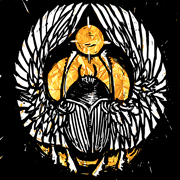

Sir Reginald F. Grump XXIII presents...
The journal of unlikely entomology

The jeep lurches hard to the left and I counterbalance right, clutching the strap above the door. Heat and white dust pour in as our forward motion is momentarily suspended. Whatever breeze we had through the window disappears. I glance back. The Dipterist from the British Museum looks sullen. My assistant next to him is hot and uncomfortable, sweat pouring down her face. Only our driver looks cool and collected.
"How much further?" I ask, just as a line of trees marking the river comes into view.
"Just ahead," the museum guy says.
A small cluster of earthy homes comes into view. We pull into a center area as children move to greet us.
An older man, tall and thin, wearing a Dragonfly Inc. t-shirt, in my honor no doubt, comes out of one of the houses and walks over to us, smiling. We are introduced. He is one of the village leaders, and he and the museum guy enter into a long conversation in Amharic.
"Ask him if any of his cattle have been sick." I interject abruptly, interrupting them. The fly guy scowls at me, but asks my question.
The man lights up, shaking his head and smiling broadly. He speaks, clasps his hands over his heart in an obvious gesture of gratitude, then pulls his t-shirt down and points to the logo. He then gives me two thumbs up and a broad grin.
The taxonomist translates unnecessarily. "No. None of his cattle have been sick."
"Anyone in the village with sleeping sickness?" I'm obviously just doing promotion work here — and trying to annoy the museum piece. The elder is wearing one of our t-shirts, for heaven's sake; I certainly don't need to play the company woman here. "Go on, ask him."
He does, and the man puts on another display of gratitude. I hate myself. I'm not out of sympathy with what the biologist is trying to do. After all, I'm here, aren't I? It's a matter of tradeoffs.
The old man, understanding without translation, says in English, "No tsetse."
An older woman and a young girl, maybe her daughter, carry out a small wooden table and set it in the shade of one of the buildings, motioning us towards it. She brings out a large, red, plastic pitcher filled with a sticky, fruity drink. She watches as we pour our drinks and doesn't react or take offense as each of us dumps in a packet of ToxFree and slowly swirl the powder into the drink. My assistant dips her finger in and rubs the rim of her glass a little too cautiously. For the first time since meeting at the airport, the museum guy and I smile at each other. It does wonders for breaking the tension. In some ways, our roles have been defined as working against each other, just by what we each represent. Conflicting interests. Still, I've tried as hard as anyone to get this right — to balance the ethics of conservation with human health. But it's hard. Mistakes are made. Sensitivity vs. specificity and all that.
We finish our drinks. My assistant then unloads the equipment, lugging a sturdy case that she plunks onto the table and opens deliberately. She takes out the device inside and hooks it up to a laptop. I set up a miniature clothesline on which the dragonflies can land.
I pull out my phone and start the App. The dragonflies come in quickly over the next fifteen minutes and land, clinging onto the little stretched wire I've set up. They are only a little smaller than real dragonflies and shine silver in the sun like jewels. One of the kids reaches out to touch one and I gently warn her away with a shake of my head. She wouldn't hurt it, they are pretty tough, but if I allow it, the other children will want to touch them too.
There are only twenty-nine out of the thirty-five we released here. Such things happen. A bat or a bird will occasionally take one, despite the built-in defenses.
"Are the markers loaded?" I ask.
My assistant nods. "Robber fly, right?"
The museum guy snaps back to his angry face. "Of course, robber fly."
I take one of the dragonflies, and open a small compartment on its thorax. I strip the wrapping off a sterile glass pipette and take a sample from the bot's stomach. A tiny sample of tissue has been snipped off with every kill, and preserved and stored en masse. It's a genetic tangle, but with the markers we can at least deduce what kinds of things it's killing.
My assistant takes the sample and inserts it into the sequencer. Almost instantly, she says, "No Asilids."
We sample only four more before we make a hit, "It's here," my assistant says sadly. We had gotten our hopes up with the first three negatives. I nod.
I have to make a point, "Are we seeing any tsetse?"
My assistant runs the markers.
"No."
"House flies?"
My Assistant answers after running those markers, "In about half the samples."
I ask, "Mosquitoes?"
My assistant runs the markers.
"No Anopheles present."
The museum guy tolerates my attempts to make a point for a while, but when I ask about earworm, he says, "Two can play at this. Any Papilio?"
That was a low blow. He knows I was involved in the worst extinction disaster of the early days of dragonfly pest control. It still stings, and in certain circles I can't show my head.
"Point taken."
So we begin trying to sort out a parameter set that will exclude robber flies from the bots' hunting phenomenology. Tradeoffs.
Still. I wish just one swallowtail butterfly would flit by.

Fearful Symmetry © Rhiannon Rasmussen-Silverstein



